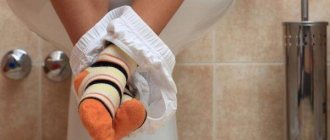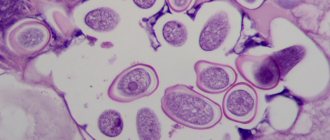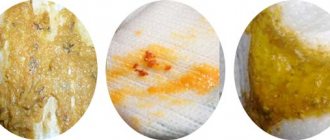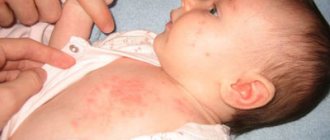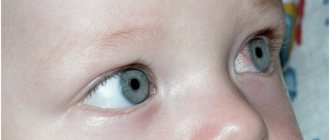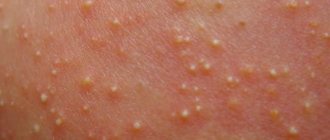Causes of detritus
Fecal detritus is formed in all parts of the digestive tract. The primary processing of food occurs in the stomach and small intestine. Proteins, fats and carbohydrates are broken down by enzymes of the pancreas and liver. The main part of detritus is formed.
The bolus of food then moves through the colon. At this time, dead red and white blood cells and desquamated mucosal epithelium join the feces. The colon contains a large number of bacteria that make up the normal microflora. Some of them die and also join the detritus.
Detritus content rate
The content of detritus in a child's feces varies depending on age and nutritional characteristics. The baby will practically not have it, because he eats only milk. The intestines of a newborn baby are sterile. It is colonized by bacteria and the formation of normal microflora occurs by the age of one year.
Detection of fecal detritus begins after 6-8 months, when the child receives complementary foods in the form of vegetable, fruit, and meat purees. At first, there is not a very large amount of detritus masses, because the food is semi-liquid. The level gradually increases as the child begins to eat solid foods and his diet becomes more varied.
In the coprogram, the amount of detritus is marked with a plus sign. The normal value is from one to five. If there is very little detrital mass, a +/- mark is placed. A high content of detritus does not always indicate the presence of a disease. It should be considered in combination with other indicators of scatological analysis.
Laboratory diagnostics
To get the result of a coprogram, you need to donate stool. The material is collected into a sterile container using a special spoon. In infants, it is collected from a diaper or diaper. For older children - from a potty. It is better to collect stool in the morning in order to immediately send it to the laboratory.
From the resulting material, laboratory assistants prepare a smear between glass slides. Then it is studied under a microscope and the content of the necessary indicators is determined. Detritus looks like a shapeless mass, sometimes small grains are visible.
Associated diseases
Deviations from the norm in detritus content may be a consequence of improper collection of tests or a sign of disease. It is impossible to judge the child’s health status based on the coprogram alone; the results of other examination methods and examination data must be taken into account.
Diseases in which the amount of detritus mass changes are usually associated with the digestive organs:
- The discovery of a large amount of detritus in combination with bacteria and mucus indicates that the child has an intestinal infection. The stool is usually loose or pasty. Characterized by abdominal pain, nausea, vomiting and fever.
- A small amount of detritus, plant fiber, and undigested muscle fibers are a sign of pancreatic dysfunction. The stool is copious, shiny, and has an unpleasant odor.
- An increase in the amount of detritus due to leukocytes and desquamated epithelial cells indicates an inflammatory process. This could be ulcerative colitis, Crohn's disease. There is occult blood in the stool. It is not visible to the naked eye; red blood cells are detected only under a microscope.
- An insufficient amount of detrital masses and dry, crumbly feces are observed with constipation. They are associated with impaired digestion of food, poor nutrition, and weakened intestinal motility.
Treatment methods
If deviations are detected in the coprogram, if a change in the amount of detritus indicates a disease, the doctor prescribes treatment. The baby's nutrition is being adjusted. In case of insufficient pancreatic function, enzyme preparations are prescribed. Detection of signs of inflammation in the intestines is an indication for the prescription of antibiotics, anti-inflammatory drugs, and enzymes. Treatment of intestinal infections is carried out with antiviral or antibacterial drugs, which depends on the cause of the disease.
Detritus is a normal indicator of scatological analysis. It assesses digestive function and is the basis of feces. A change in its content should be considered as a pathological condition only if the child has complaints or deviations in other indicators of the coprogram.
Let's look at detritus in the coprogram, what it is, and whether its presence is normal. And what to do. So, a coprogram is a comprehensive laboratory study to assess the functioning of the gastrointestinal tract (GIT). One of the criteria being determined is detritus, and its content in the biomaterial under study can vary from insignificant to large. It is important to understand what a large amount of detritus indicates in a stool analysis and whether it is a pathological sign.
Indications for the study
A scatological examination is prescribed in several cases: for symptomatic patient complaints (blood in the stool, constant pain and cramps in the abdomen, intense gas formation, constipation (constipation), diarrhea, etc.), as part of a general diagnosis of diseases of the gastrointestinal tract (gastro- intestinal tract) and hepatobiliary system, as well as oncological diseases.
In addition, the doctor prescribes tests for suspected pathologies:
- inflammatory lesions of the digestive system;
- venous swelling in the rectum and anus (hemorrhoids);
- Crohn's disease;
- cirrhosis of the liver;
- oncology and bleeding of the gastrointestinal tract;
- colon polyps.
The study is not carried out for preventive purposes. How much coprogram is done depends on the medical institution where the biomaterial was accepted for analysis. In Moscow and other large cities, the deadline is one day. A general stool test for coprogram is prescribed when it is suspected:
- parasitic infestation (worms) and amoebic dysentery;
- infection and poisoning.
The value of the study in these cases lies in its efficiency, that is, the ability to quickly detect and identify the pathogen. Young children are prescribed to have feces submitted for scatological microscopy in case of allergic reactions, colic, as well as other problems with stool and digestion, in order to diagnose helminthiasis in a timely manner.
Detritus in a child's stool - what is it?
Detritus in coprogram is a collection of tiny particles of digested food and bacterial microflora, which are naturally eliminated from the human body.
The analysis is also relevant in gynecology: for example, detritus in a smear in women is represented by cells of desquamated epithelium and representatives of normal vaginal microflora.
A separate analysis for detritus in the feces of a child or an adult is not carried out; its quantity is determined as part of the coprogram; the research method is microscopy. The deadline does not exceed 24 hours, excluding the day when the biomaterial was delivered to the laboratory.
If a gynecological smear is mandatory and is carried out every time a woman visits a doctor, then a doctor (generalist, pediatrician, gastroenterologist, surgeon, infectious disease specialist) prescribes a referral for a coprogram if there are symptoms of a disturbance in the normal digestive process:
- lack of appetite and sudden loss of body weight of unknown etiology;
- stomach ache;
- flatulence;
- bloating;
- blood clots in stool;
- loose stools or frequent constipation;
- unnatural color of stool;
- nausea with bouts of vomiting.
In addition, it is advisable to carry out the analysis during drug therapy for the purpose of early diagnosis of side effects, as well as after its completion to determine its effectiveness.
Diagnosis
Before starting treatment for steatorrhea, a detailed examination is performed, the main task of which is to identify the causes of the formation of this condition.
The doctor interviews the patient in detail, clarifies the features of vital activity and daily diet. Only then are studies prescribed:
- Blood, feces, and urine are submitted to the laboratory for analysis;
- Ultrasound and MRI.
The duration of pathological changes may cause additional diagnostic measures aimed at assessing possible complications, which often occur after deviations in the absorption of fats.
Normal indicators
Only the attending physician can establish normal values for the content of detritus in feces. At the same time, the isolated use of a criterion or coprogram to establish a final diagnosis is unacceptable. A comprehensive examination, in addition to laboratory diagnostics, should be accompanied by ultrasound of the abdominal organs and gastroscopy.
In most cases, detritus in the coprogram is also detected normally, which explains such a wide spread of acceptable criterion values in the analysis results from small to significant. As a rule, healthy children and adult patients show a moderate content of detritus in the biomaterial being studied.
A complete digestion process involves the release of undigested and digested remains of the food bolus. At the same time, representatives of the intestinal microflora are also isolated, which is a variant of the physiological norm.
Results
Analysis of stool for scatology (coprogram) is an informative laboratory method for the primary diagnosis of the condition of the organs of the digestive system and assessment of their performance. The study allows you to detect dysfunctions of the stomach, liver, small and large intestines, pancreas and bile ducts.
Based on the results of coproscopy, the doctor will promptly refer the patient for further examination. To obtain the most informative data, prior preparation and compliance with the rules for collecting biomaterial are required before submitting the analysis. The coprogram has no age restrictions and is performed on children from infancy.
A coprogram is the result of a diagnostic study, known under several names: scatology, coproscopy, general stool analysis.
The essence of the procedure is to study the physical, chemical and microscopic properties of human feces in order to determine possible gastrointestinal pathologies. Until the moment when the food bolus (chyme) gives up its beneficial components and is converted into feces, it successively passes through all the organs of the digestive system and is processed. That is why the condition and composition of feces can be used to judge many disorders, ranging from inflammatory processes and parasitic infestations to cancer of the stomach, liver, intestines, and pancreas.
When you have a ready-made coprogram in your hands, decoding can cause difficulties, since opposite the indicators in the form there will be letter abbreviations, numbers, or even just pros and cons, but what they mean is not clear. Of course, the doctor will answer your questions, but almost any person is interested in understanding the results of the examination for himself. We will help you with this and tell you in an accessible language about how to correctly take a coprogram, what this diagnostic procedure shows, who needs it, what are the norms for a general stool analysis in children and adults, and what deviations from healthy indicators may indicate. But we would like to emphasize that the information provided does not replace medical advice, especially if there is a serious illness.
Deviation from the norm
What changes in the indicator under consideration indicate pathology? If the amount of detritus is of no diagnostic value, then its qualitative characteristics are of decisive importance and indicate various diseases of the gastrointestinal tract. Examples of deviations from the physiological norm:
- a large amount of undigested fiber in combination with detritus indicates a disruption of the biliary tract and the act of digestion in the small intestine, often accompanied by constipation;
- mucus or leukocytes in detritus are a sign of an infectious disease or dysbacteriosis (disturbance in the composition of normal intestinal microflora);
- the predominance of destroyed bacterial and epithelial cells is observed in acute inflammatory processes;
- the absence of detritus in combination with diarrhea indicates disturbances in the absorption of nutrients in the intestinal tract;
- an abundant content of detritus, represented by fatty molecules, indicates pathologies in the functioning of the pancreas or liver.
Possible complications
Deviations in the absorption abilities of the intestinal tract are caused by:
- tissue swelling;
- gross deformations of nerve intertwining.
It should be noted that the disease can be chronic. Relapses occur frequently because they are quickly provoked by negative factors.
The body stops absorbing fats, which causes a lack of fats. There is also a lack of other beneficial components - proteins, fat-soluble vitamin complexes. Organ cells are deficient in certain acids, which can result in hyperchromia, hypolipia, anemia and other problematic diseases.
Preparing for coprogram
Proper preparation determines the accuracy of the research data obtained. The biomaterial for analysis is feces, which must be collected naturally. It is allowed to take feces from the surface of the baby's diaper. For children - from a previously washed (without chemicals) potty. Adults collect feces that have not touched the bottom of the toilet.
For 2 days, it is necessary to exclude medications that affect intestinal motility (laxatives, prozerin ®, vasopressin ®, belladonna ®) and the color of stool (carbolene ®, iron).
The biomaterial is collected in a special sterile container, which can be purchased at the laboratory or pharmacy. Temperature optimum for storage is from +2 to + 8° C (refrigerator).
Types of steatorrhea
The pathology manifests itself in the following forms:
- food – the second name is “alimentary”. It is characterized by excessive consumption of fats, which even an organism in good health cannot cope with;
- intestinal - appears as a result of damage to the mucous membrane of the intestinal tract (small section). In this case, the beneficial components contained in food products are not absorbed normally;
- pancreatic - this diagnosis is made if the functioning of the pancreas is impaired. At the same time, a small amount of lipase is produced that can break down fats.
There are several more varieties of the disease - with the presence of fats in fecal matter, with the identification of fat-containing acids and soaps, of a mixed type.
Detritus in a smear for flora in women
A gynecological smear is taken from the urethra, vagina and cervix. In this case, only representatives of the normal microflora of the woman’s vagina should be diagnosed in the detritus. In case of inflammation of the internal genital organs, infectious infections or vaginitis, pathogenic species of bacteria or abundant unnatural secretion of normal microflora are detected. Normally, the cervix and urethra are completely sterile. In this case, a moderate number of epithelial tissue cells is allowed in the analysis results.
Certified specialist, in 2014 she graduated with honors from the Orenburg State University with a degree in microbiologist. Graduate of the graduate school of the Federal State Budgetary Educational Institution of Higher Education Orenburg State Agrarian University.
In 2015 At the Institute of Cellular and Intracellular Symbiosis of the Ural Branch of the Russian Academy of Sciences, she completed advanced training in the additional professional program “Bacteriology”.
Laureate of the All-Russian competition for the best scientific work in the “Biological Sciences” category 2021.
There comes a time in the life of every parent when their baby is scheduled for the first tests. These include examination of stool (coprogram)
, which allows you to assess the health of the digestive system, as well as identify pathologies and parasitic lesions.
Existing types of stool tests
Modern medicine performs several types of stool tests in children.
They are aimed at determining the cause of the disease and have their own characteristics. The most common stool tests in children are:
- A general stool test, or scatological test, is carried out to determine the health of the child’s digestive tract and the entire body as a whole. It shows the big picture and can be the basis for in-depth research.
- Bacteriological analysis of stool, tank analysis, tank culture. This type of stool sample is aimed at detecting in the child’s body traces of the vital activity of various bacteria and other causative agents of serious and dangerous diseases - salmonellosis, cholera, typhoid fever, cholera, dysentery, shigellosis and many others. Each of these diseases can cause serious harm to the child’s health and cause complications and pathologies in the future.
- Analysis for the presence of helminth eggs. Worms and protozoan microorganisms are often the main causes of disease in children. They are very common in children who constantly pull various objects, simultaneously becoming infected with parasite eggs. Once they enter a child's digestive system, they can form an entire colony and cause serious health problems. This analysis helps to identify the presence of a variety of worms (pinworms, roundworms and many others), protozoa (amoebas and lamblia), as well as E. coli and other intestinal pathogens. Testing for the presence of pinworms (enterobiasis) is carried out differently than other stool samples for worm eggs.
- A fecal occult blood test is a specific test performed if there is a suspicion of internal bleeding or bleeding ulcerative lesions of the child’s gastrointestinal tract.
- Analysis for dysbacteriosis helps to identify the body's response to antibiotics of different groups.
Timely testing and interpretation of stool analysis in children helps to determine the presence of a specific disease in the early stages of its development, begin treatment on time, and maintain the health of the little patient.
More information about general stool analysis can be found in the video.
Indications for taking a coprogram in a child under one year old
Fecal analysis in newborns and infants is a very important part of the diagnosis of many diseases. Such a study is prescribed for children under one year of age in the following cases:
- A routine examination of the condition of the children's digestive tract, which is carried out at the end of the first month of life.
- When a baby is admitted to the hospital, the coprogram is included in the mandatory tests along with blood and urine tests.
- Before carrying out preventive vaccinations (to exclude contraindications).
- In case of suspected pathologies of the digestive system, as well as other organs.
It is worth noting that a coprogram is not passed if the baby the day before received laxatives, sorbents, preparations containing iron and dyes. In such cases, indicators may change.
Why do you need a stool test?
Pediatric stool analysis
Among all the tests performed on a child, a stool sample gives the most vivid picture of the state of the gastrointestinal tract and internal organs directly related to it. It can serve as evidence of both various diseases and as confirmation of the child’s excellent health.
Correctly performed interpretation of stool analysis in children will help determine the presence of different types of worms, bacterial infections, and document disturbances in the functioning of internal organs. Feces will show how well the food is digested, how it is absorbed and whether it is harmful to the baby.
Using a stool sample, you can identify problems with the liver, such serious diseases as dysbiosis and E. coli.
This analysis is performed on children literally from the first months of life. During infancy, it can demonstrate how well breast milk or formula is digested. For older children, the range of analysis results is much wider. Such a test may need to be taken when visiting several specialists, since if various diseases are suspected, different types of tests will be required.
Some diseases may be asymptomatic, or the child, due to his small age, cannot correctly describe his sensations, tell where he feels pain or discomfort. For very young children who have not yet learned to speak or communicate at an elementary level, stool analysis may be the only indicator of a digestive disorder or the presence of a number of diseases.
Preparation and procedure for submitting a coprogram for a newborn and infant
If your baby is scheduled for a stool test, you must properly prepare your baby and collect the stool. This is very important for the accuracy of the indicators. To avoid difficulties in making a diagnosis and the need for repeated analysis, follow some rules:
- Before collecting material, you should not give the baby laxatives, sorbents, place a heating pad on the tummy, or give enemas.
- Stool must be collected in a special container with a spatula built into the lid, which can be purchased at any pharmacy.
- If the baby is already receiving complementary foods, then a few days before the test it is advisable to refuse it.
- It is best to collect the material in a container in the morning and immediately take it to the laboratory. But there are situations when this is impossible to do. For example, if the baby defecated at night, the stool can be stored in a tightly closed container in a cool place until the morning. This can be done provided that the feces are immediately taken to the laboratory in the morning.
- A nursing mother should temporarily avoid medications containing iron and dyes.
How to properly collect feces for coprogram?
- Before collecting the material, the baby needs to toilet the perineum and genitals.
- If possible, it is better to place the child on an oilcloth surface or sit on a potty before defecation (if age permits). This will make it easier to collect the feces.
- You can put a self-made diaper from a diaper on your baby. It is acceptable to take material for research from a diaper with filler, but if possible it is better not to use this method: firstly, liquid feces will be immediately absorbed, and secondly, the indicators may not be entirely accurate.
- It is necessary to take feces with a special spatula from several different places. Do not put the entire contents of the diaper into the container, just 10-15 grams is enough.
- It is very important that urine does not get into the container along with feces.
To avoid the need for repeated studies, it is very important to adhere to all the rules. You can seek additional advice from a pediatrician or laboratory assistant.
